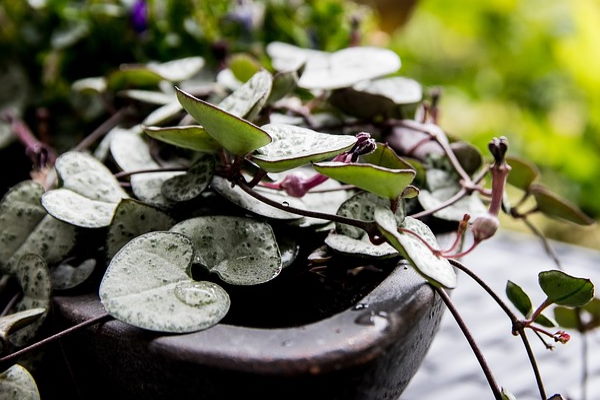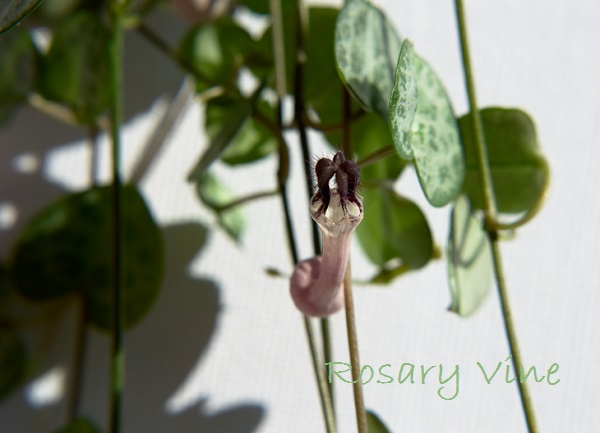How to Grow Rosary Vine
Whether you call it Rosary Vine or String of Hearts, you'll be captivated by this charming house plant.
Known botanically as Ceropegia woodii, this beauty has exquisite heart-shaped leaves that grow along slender stems. Display Ceropegia in a hanging basket to show off those long, heart-studded vines.
 Heart-shaped patterned leaves make Rosary Vine eye-catching. Photo credit
Heart-shaped patterned leaves make Rosary Vine eye-catching. Photo creditGet to Know Ceropegia Woodii
This semi-succulent grows from 2-inch (5 cm) tubers that rest on the surface of the soil. Several purple stems (also called runners) will grow from each tuber.
Pairs of heart-shaped leaves grow about every 3 in (8 cm) along the slender stems. Each leaf will eventually grow to about 1-inch (2.5 cm) long. Decorative all on their own, the leaves are splotched with a lacy pattern of silvery white on the top and are purple underneath.
How big does it get? Rosary vine trails up to 10 ft (3 m). Too long? Don't worry... you can cut those vines back any time.
Native to South Africa, this semi-succulent likes the same warm temperatures we do. It's also fast-growing and long-lived, so you'll enjoy your houseplant a long time.
Ceropegia woodii is a captivating houseplant and is easy to grow.
How to Propagate Ceropegia Woodii
Small tubers sometimes grow along the stems, causing the stems to branch out. You can remove the tubers anytime and set them on the surface of the soil to grow more plants in the same pot.
Here's how: Take stem tip cuttings and insert cut ends in moist soil. Or cut off stem tubers and place them on the surface of the soil, where they'll root quickly.
Give your cuttings indirect light to promote growth, but keep them out of harsh, direct sunlight, which can scorch young leaves.
Rosary Vine Solutions, Answers and Houseplant Help
Prune it back when Rosary Vine starts to look leggy. Propagating the stem cuttings by inserting them back in the soil will give a fuller display that's lush with leaves.
Soft, yellow leaves are a symptom of over-watering. Allow potting medium to dry between waterings. Cut off affected stems at the soil level. Don't worry, this fast-growing plant will soon replace them.
Curling, brown or crunchy leaves often are a sign of dry soil. Although this semi-succulent is not tolerant of soggy soil, it does need watered regularly. Cut off any affected stems.
Repot in spring when it gets crowded, moving to a pot only 1-2 inches (2.5-5 cm) bigger. This vining plant grows from 2-inch (5 cm) tubers. Place them on the surface of the soil and they'll root quickly. Use a sandy mix and a pot with a drainage hole to avoid soggy soil, which can cause the tubers to rot.
Something bugging your houseplant? Rosary Vine seems to shrug off pests, but watch for webbing between leaves and stems -- a tell-tale sign of spider mites. These tiny pests are attracted to houseplants, especially during the winter months when indoor air can become extremely dry. Treat any infestation immediately to prevent pests from moving on to your other houseplants. Raising the humidity around your houseplant can help prevent an infestation.
Is Ceropegia woodii poisonous? No. It's not toxic. But I can see how its long, dangling leaves may appeal to playful cats and dogs. That's another good reason to hang it up, away from curious pets.
Why You Should Grow Rosary Vine
This carefree classic beauty was once an extremely popular indoor plant, but not as common these days. Perhaps it has fallen out of favor because it is so easy to grow? Somehow easy-care plants get less respect. If you come across this beautiful succulent vine, buy it. It's long-lived and easy to propagate for more plants.
You may find rosary vine for sale at online nurseries or at your local garden center. It is usually labeled by its genus and subspecies names, Ceropegia woodii.
A more colorful variety exists, Ceropegia woodii var. 'Variegata' has grayish-green leaves edged with creamy white. With lots of bright sunlight, the edges may turn pink.
 Ceropegia looks best set high, allowing its stems to cascade. Photo © Agata Buczek
Ceropegia looks best set high, allowing its stems to cascade. Photo © Agata BuczekRosary Vine Care Tips
Light: Keep your plant in bright light (with some direct morning sun) for best color and plenty of leaves. Long spaces between leaves are a sign it's not getting enough sunlight.
Water: Keep the soil lightly moist in spring and summer. Water sparingly in fall and winter, when growth is slow. A semi-succulent, this plant is more tolerant of dry soil than wet. In fact, one sure-fire way to kill Rosary Vine is to over-water. Use a pot with a drainage hole to prevent soggy soil, which can lead to stem rot or root rot.
Humidity: Moderate (around 45% relative humidity). If indoor air is dry, use one of these easy ways to increase humidity for your houseplant. During the winter months, indoor air can become extremely dry; using a humidity monitor will take away any guesswork.
Temperature: Normal room temperatures (65-80°F/18-27°C) will suit this vine year-round. Don't expose this warm-natured plant to temps below 55°F/13°C.
Soil: Mix 1 part good-quality, all-purpose potting mix and 1 part sand or perlite for fast drainage. Cactus potting mix works beautifully to give Rosary Vine the fast drainage it needs.
Fertilizer: Feed monthly in spring and summer with balanced water-soluble fertilizer. It's a good idea to fertilize houseplants after watering to prevent burning roots. Don't feed in fall and winter when growth is slower.


